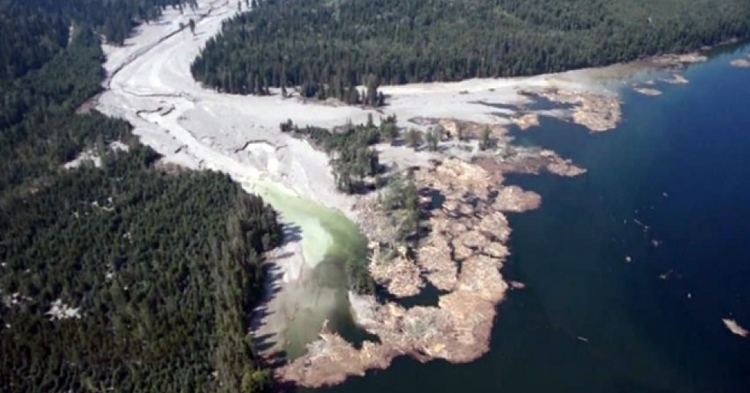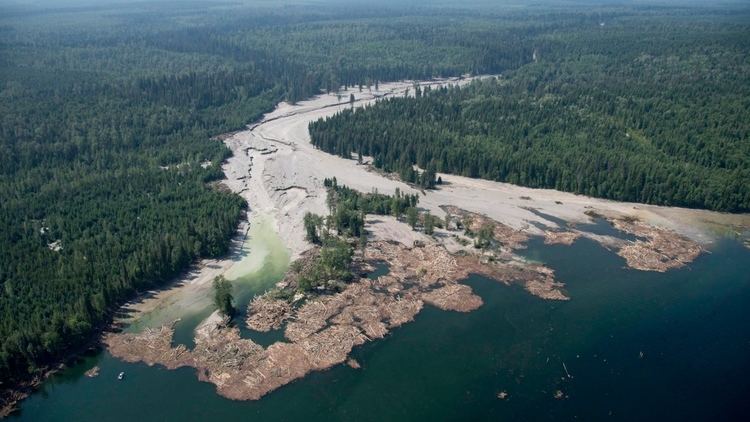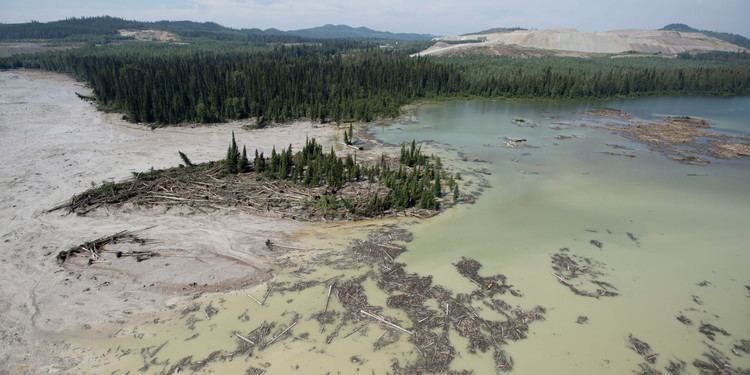Footage Footage: Youtube Date 4 August 2014 | Location Quesnel Lake, Canada Location Quesnel Lake | |
 | ||
Cause Failure of tailings pond dam Similar Fraser River, 2015 Gold King Mine waste wat, Merriespruit tailings dam disa, Val di Stava dam collapse, Bento Rodrigues dam disa | ||
The Mount Polley mine disaster is an environmental disaster in the Cariboo region of central British Columbia, Canada, that began 4 August 2014 with a breach of the Imperial Metals-owned Mount Polley copper and gold mine tailings pond, releasing its water and slurry with years worth of mining waste into Polley Lake. The spill flooded Polley Lake, its outflow Hazeltine Creek, and continued into nearby Quesnel Lake and Cariboo River. By 8 August the four square kilometres sized tailings pond had been emptied of the majority of supernatant (process water) that sits atop the settled solids (mining waste, or 'tailings'). Water tests showed elevated levels of selenium, arsenic and other metals similar to historical tests before the disaster. The cause of the dam break has been investigated with a final report published 31 January 2015. Imperial Metals had a history of operating the pond beyond capacity since at least 2011.
Contents
- Dam breach
- State of local emergency
- Pollution Abatement Order
- Immediate control
- Environmental monitoring and impacts
- Engineering monitoring and inspection
- Investigation of root cause
- Political responses
- US concerns
- Imperial Metals history
- References

Dam breach

The Mount Polley open pit copper and gold mine disaster in the Cariboo region of British Columbia began in the early morning of 4 August 2014 with a partial breach of the tailings pond dam, releasing 10 million cubic metres of water and 4.5 million cubic metres of slurry into Polley Lake. The slurry of tailings and process water carried felled trees, mud and debris and "scoured away the banks" of Hazeltine Creek which flows out of Polley Lake and continued into the nearby Quesnel Lake. The spill caused Polley Lake to rise by 1.5 metres (4.9 ft). Hazeltine Creek was transformed from a 2-metre-wide (6.6 ft) stream to a 50-metre-across (160 ft) "wasteland"* and Cariboo Creek was also affected. As of 8 August 2014, a "slurry of toxic water and mud" continued to pour into the once pristine Quesnel Lake, the cleanest deep water lake in the world. By the end of the day the four square kilometres sized tailings pond was "virtually empty". Mine safety experts and media articles have called the spill one of the biggest environmental disasters in modern Canadian history. British Columbia’s government initially insisted the dam failure was not an environmental disaster, a position British Columbia’s Environment Minister, Mary Polak, reversed in November 2014.
State of local emergency

On 6 August 2014 Cariboo Regional District declared a local state of emergency in several nearby communities, including Likely, British Columbia, partly because of concerns over the quality of drinking water, which affected 300 residents. On August 9, water use restrictions were removed for residents of Likely and downstream from that community based on water quality testing by the BC Government. However, the government continued the advisory for points upstream of Likely. On August 12, Interior Health further rescinded the ban on drinking water, narrowing the “Do Not Use” order to only the impact zone directly affected by the breach, which includes Polley Lake, Hazeltine Creek, and an area within 100 metres of the shoreline sediment deposit, where Hazeltine Creek runs into Quesnel Lake. This remaining advisory is expected to stay in place indefinitely. The government advised that boiling the water would not help in the "do not use" areas. All five testing sites of the second water test run had zinc levels above chronic, or long-term, exposure limits for aquatic life.

The government described the purpose of the state of local emergency was to provide "exceptional" powers in the interest of public safety, and an equitable distribution of potable water to the residents of Likely. All tourism businesses in the affected areas remained open. Because the affected water system is salmon-bearing, there was a temporary closure of part of the Chinook salmon fishery by Fisheries and Oceans Canada. Fishing along the Fraser River was not affected. Rainbow trout toxicity test results from water collected at Quesnel Lake near the mouth of Hazeltine Creek on August 5 and 6 showed water was not toxic to rainbow trout.
Pollution Abatement Order

On August 6, two days after the breach, the British Columbia Ministry of Environment issued a Pollution Abatement Order to Mount Polley Mining Corporation. The company submitted an action plan for the Preliminary Environmental Impact Assessment, environmental monitoring, stopping the flow from the "Tailings Impoundment" breach, as required. The company was required and did report weekly on the implementation of action plan measures.
Immediate control

In August MPMC submitted an interim erosion plan and a sediment control plan to mitigate ongoing erosion and sediment transport downstream, to control further flow from the tailings area, and to improve the quality of water flowing into Quesnel Lake. In the beginning of September 2014, a berm to prevent further spread of tailings was nearing completion and laid off workers, about 40 of the mine’s approximately 300 workers demanded to reopen the mine. a spokesman at the Ministry of Mine said operations would require permits and approvals and could only go ahead after a rigorous review.
Environmental monitoring and impacts
According to an Imperial Metals summary filed with Environment Canada in 2013 "there was 326 tonnes of nickel, over 400 tonnes of arsenic, 177 tonnes of lead and 18,400 tonnes of copper and its compounds placed in the tailings pond [last year]". At a community meeting on 5 August 2014, president of Imperial Metals, Brian Kynoch, claimed the water in the tailings pond was almost potable, "though the silt, the "ground-up rock" left over after extracting the metals" posed a problem.
Water, sediment, and fish in Polley and Quesnel Lake are monitored by BC government staff. Fish sampling revealed elevated levels of selenium, that exceed guidelines for human consumption as well as elevated levels of arsenic and copper not considered a threat to human health. These levels were similar to levels found in 2013 before the tailings breach, and considered likely due to local geology.
Sediment testing near the tailings spill revealed elevated concentrations of copper, iron, manganese, arsenic, silver, selenium and vanadium. The government said tests in May 2014, before the tailings release, had shown elevated levels of the same elements.
The extent of the damage is predicted to "remain unknown for years or even decades', as toxicants slowly accumulate in the environment. It should be noted however, that the geological nature of the tailings is such that the minerals present in the tailings will not readily dissolve into the waters affected as the pH of the waters is not low enough to promote dissolution of the minerals and therefore would lessen their bio-availability.
Engineering monitoring and inspection
In 2010, Mount Polley Mining Corporation's (MPMC) engineering firm reported a 10 metres crack in the earthen dam while working to raise it, and that piezometers were broken, which per MPMC were later fixed.
in 2010 then-premier Gordon Campbell had cut funding for seven ministries responsible for resource management which were reorganized into a “single team” approach. Inspections across the province decreased from 22 in 2009 to 3 in 2010, two in 2011, and none in 2012. Mount Polley was last inspected in 2013, but not 2011 or 2012. Bill Bennett, Minister of Energy and Mines, said "there is no evidence that the government’s missed inspections were related to the failure of the dam this year".
Investigation of root cause
On 18 August, the BC government with support of the Soda Creek Indian Band and Williams Lake Indian Band ordered an independent engineering investigation into the pond breach, and a third-party review of all 2014 dam safety inspections for every permitted mine's tailings pond in the province. The panel reviewing this breach was composed of Norbert Morgenstern, P.Eng., Dirk van Zyl, P.Eng., and Steven Vick. Their final report was published January 31, 2015. The investigation covered many factors including the question of whether the piezometers measuring the water pressure on the dam had been located correctly. The last readings, 2 August 2014, did not show any changes in the water pressure. On 1 February 2015, the Globe and Mail reported a principal finding of the panel determined the tailings dam collapsed because of its construction on underlying earth containing a layer of glacial till that had been unaccounted for by the company's original engineering contractor.
Political responses
The University of Victoria Environmental Law Centre filed a complaint with B.C.’s privacy commissioner regarding the government not releasing environmental assessments and dam inspection reports about Mount Polley mine; after journalists found a dam inspection report from 2010 and environmental assessments from 1992 and 1997 in public libraries, the B.C. government has withheld subsequent reports. Indigenous political activists led by Kanahus Manuel set up illegal blockades and held numerous community based protests against Imperial Metals following the disaster.
U.S. concerns
Since the spill, Alaskan mine opponents including environmentalists such as Trout Unlimited Alaska, aboriginal peoples, the fishing industry and politicians point to several planned B.C. mining projects involving three major salmon-producing river systems that run downstream into Southeast Alaska: The large Red Chris gold and copper mine owned by Imperial Metals Corp is now in operation and located in the headwaters of the Iskut River, a major tributary of the Stikine River whose estuary is near Petersburg and Wrangell Alaska; The KSM project owned by Seabridge Gold Inc has been approved by B.C., awaits federal approval and is located near the Unuk River system supporting one of Southeast Alaska’s largest Chinook salmon population, and flows into Alaska, although its tailings facility would be located in the Nass River watershed emptying into the Pacific in B.C. A third mine is slated to reopen and expand in the Taku River near Juneau.
Imperial Metals history
The controlling shareholder of Imperial Metals is billionaire N. Murray Edwards. He donated half a million dollars in campaign contributions to the B.C. Liberal party since 2005 and helped organize a $1-million fundraiser for B.C. Premier Christy Clark’s re-election.
Imperial Metals & Power Ltd was incorporated in British Columbia in December 1959. Beside the Mount Polley open pit copper mine and gold mine it owns the Red Chris copper/gold mine and has a 50% interest in the Huckleberry open pit copper mine and the Ruddock Creek zinc/lead project.
